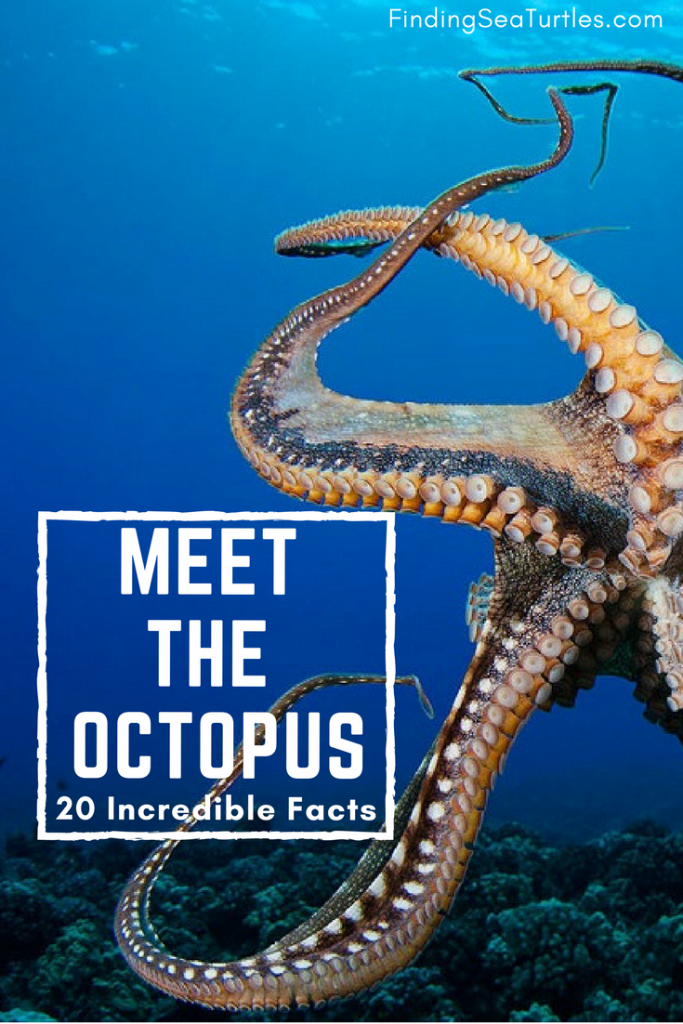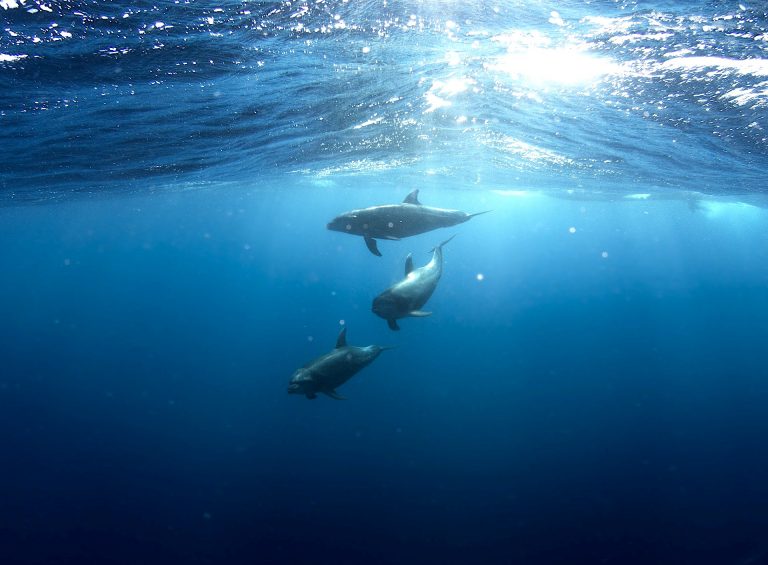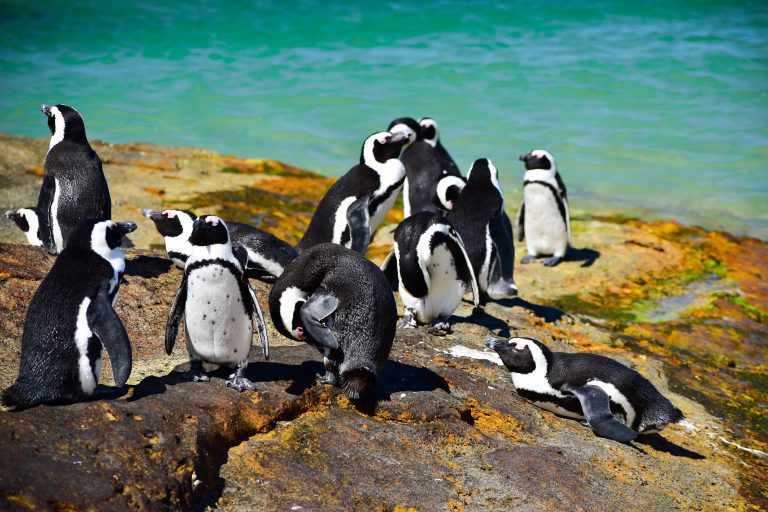Sealife Spotlight: 20 Octopus Facts You Didn’t Know
Let’s take a look at what octopus facts makes this ocean dweller so special. Why eight? The Asian culture holds the number eight in high regard and considers it lucky. Who are we to argue that having eight arms isn’t a great thing. It seems to work for one of the ocean’s most intelligent, endearing and sometimes misunderstood invertebrate. Some of us just love the thought of something capable of running around with eight arms multi-tasking. Anyone trying to keep up with a blog, little kids, a few pets and a household to run can FULLY appreciate this!
There are about 300 different species of octopus. This represents over two thirds of all the species in the family of cephalopods (which also includes close cousins the squid and cuttlefish). Octopus can range in size from just barely an inch to over 30 feet in arm span!
Here are 20 very interesting Octopus facts you may not have known:
- Octopuses have been around for a LONG time. The oldest fossil record is over 296 million years old, putting them as far back as the Carboniferous period.
- The Octopus has quite the list of awkward physical traits: it is a baggy, boneless invertebrate that can pour itself into the tiniest spaces. It has venom like a poisonous snake, a irritant-laced ink that can be released like pepper spray, a crushing, powerful beak like a parrot to crush through shells, skin that can taste via touch, and a body that can change color and texture near instantly for camouflage.
- The smallest Octopus is just under an inch in length while the largest is the Giant Pacific Octopus that can have an arm span of nearly thirty feet and weigh six hundred pounds.
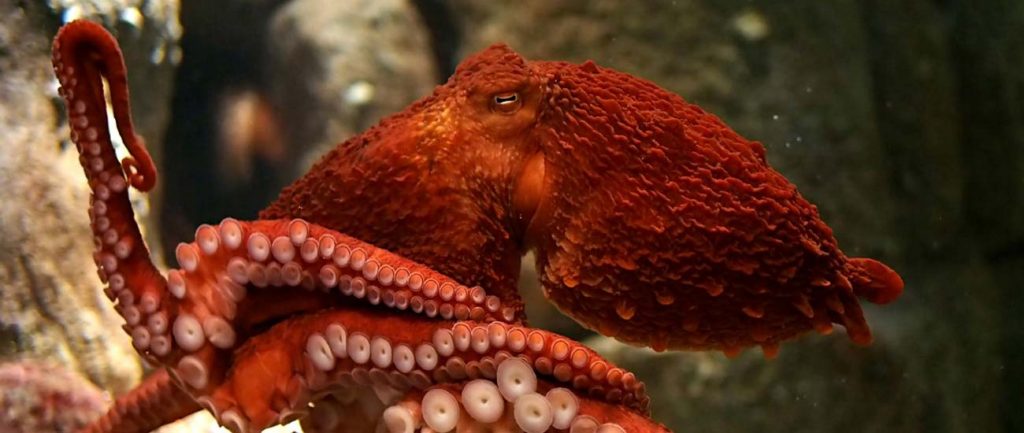
- Bottom-dwelling octopuses have a diet primarily of crustaceans, polychaete worms, and other molluscs while open-water species will eat fish, prawns and other cephalopods.
- The Octopus has one central brain but also uniquely has a giant ganglion or bundle of nerves at the base of each arm. This suggests brain functions are distributed across the brain and eight arms. A human has 4 lobes that make up the brain. An octopus’ brain has 50-75 lobes!
- Approximately two-thirds of an octopus’ neurons are not in their central brain. This suggests that much of the octopus’ sensory processing and thinking is distributed across its arms. This is different than how our brain centralizes much of our processing. This means their arms might literally have a mind of their own!
- Here is a strange but interesting octopus fact: they have three hearts! Two hearts are dedicated to constantly pumping blood to the gills for oxygen. The third heart circulates oxygen-rich blood to the organs. How cool is that?
- Octopuses have blue blood! Octopuses are found in warm and cooler waters. But for those species that live in colder water and even deep sea levels, oxygen levels are poor. The octopus has a copper-based blood versus the more common iron-based (like humans). At low ocean temperatures, copper is more effective at oxygen transfer than iron.
- The average octopus has about 240 suckers per arm and therefore over 1600 suckers in total. On particularly large octopuses, an individual sucker is capable of holding up to thirty-five pounds. Each sucker is extremely sensitive to both physical touch and chemical receptors allow detection of many changes. Each sucker can be individually controlled and even folded over in a pinching gesture.

- An octopus swims by purging water out of its body (jet propulsion). When a bottom-dweller species swims like this, its third circulatory heart actually stops temporarily. These octopuses can quickly get exhausted swimming hence their natural tendency to crawl when not in a rush.
- Another lesser known octopus fact is that their lifespan is unfortunately very short, on average only one to two years with the upper end being four to five years for the largest giant species.
- This is the one octopus fact you should pay attention to: one species, the Blue-Ringed octopus, carries one of the most lethal venoms in the animal kingdom and certainly within the ocean. It is similar to the one found in the pufferfish. An adult blue-ringed octopus carries enough toxin to kill twenty six humans. Be careful, there is currently no antidote!

- An octopus is able to survive out of water as long as sixty minutes depending on other conditions including humidity and exposure to sun.
- Here’s a sad but true octopus fact: female octopuses mate and lay eggs as their final task before dying. But they will guard those eggs until they hatch. The deep sea octopus (Graneledone boreopacifica) guards its eggs for over four years! After the eggs hatch, the Octopus’ body is designed to begin cellular-level death.
- Octopuses are one of the few animals that have evolved to use tools. For example the coconut octopus has an amusing fondness for empty coconut shells and collects them for defense and hiding.

- Here’s one of the cooler octopus facts: they are natural-born camouflage artists. Their very unique skin has all sorts of receptors and specially-evolved cells that can change color within three tenths of a second to mimic their background. They can also physically reshape to mimic texture so the octopus can blend better into the background (e.g. plant growth and coral).
- Although we associate ink more to the squid, Octopus also have an ink that can be released for a quick escape. This ink makes an obvious smokescreen to escape unseen. But the ink also contains tyrosinase which causes blinding irritation and confused smell and taste in predators. This ink is so potent that octopuses can be harmed by their own cloud if they aren’t able to escape it.
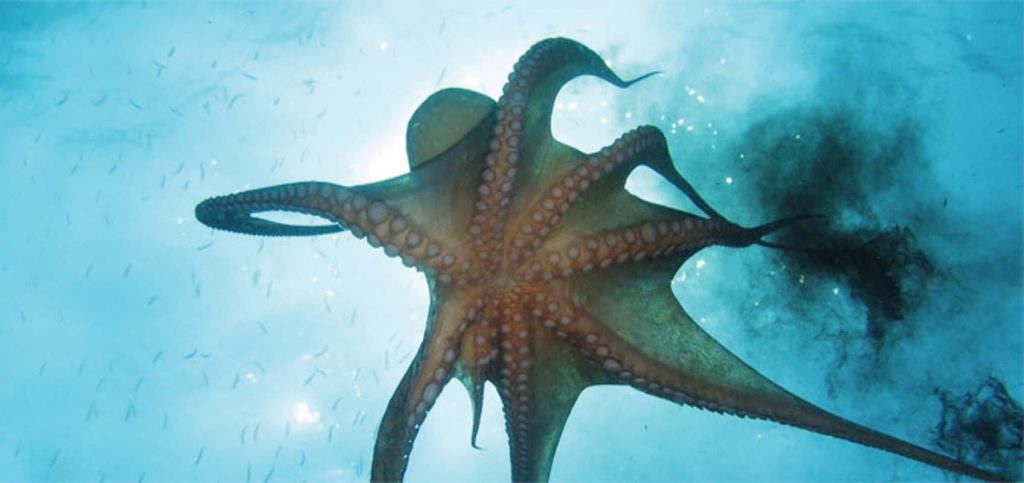
- Another interesting octopus fact is that it can kill a shark! Who would have thought the top-of-the-food-chain predator shark has a foe in the wiley octopus. The Seattle Aquarium has a video documenting a resident octopus hunting and killing a dogfish shark.
- Octopuses are extremely intelligent and have been observed learning very quickly to do amazing things like opening a child-proof pill bottle. They are escape artists in the truest sense and many researchers and aquariums spend a lot of energy trying to make their octopus tanks escape-proof!
- Because of their high intelligence, they like and need the stimulation of play! Both in the wild and in captivity, octopuses have been observed playing with objects and caretakers and seem to crave interaction with their natural curiosity.

We hope this list of Octopus facts have taught you a few new things about the super-intelligent octopus. And if you’re curious how you can incorporate the Octopus into your home decor, check out our post on 10 Cool Octopus Accessories for Your Home Decor.
Please leave us comments about your encounters with an octopus or if you have any questions.
If you’re interested in learning some interesting facts about other sea life, check out our other posts in the Sealife Spotlight series:
Thanks for reading!

